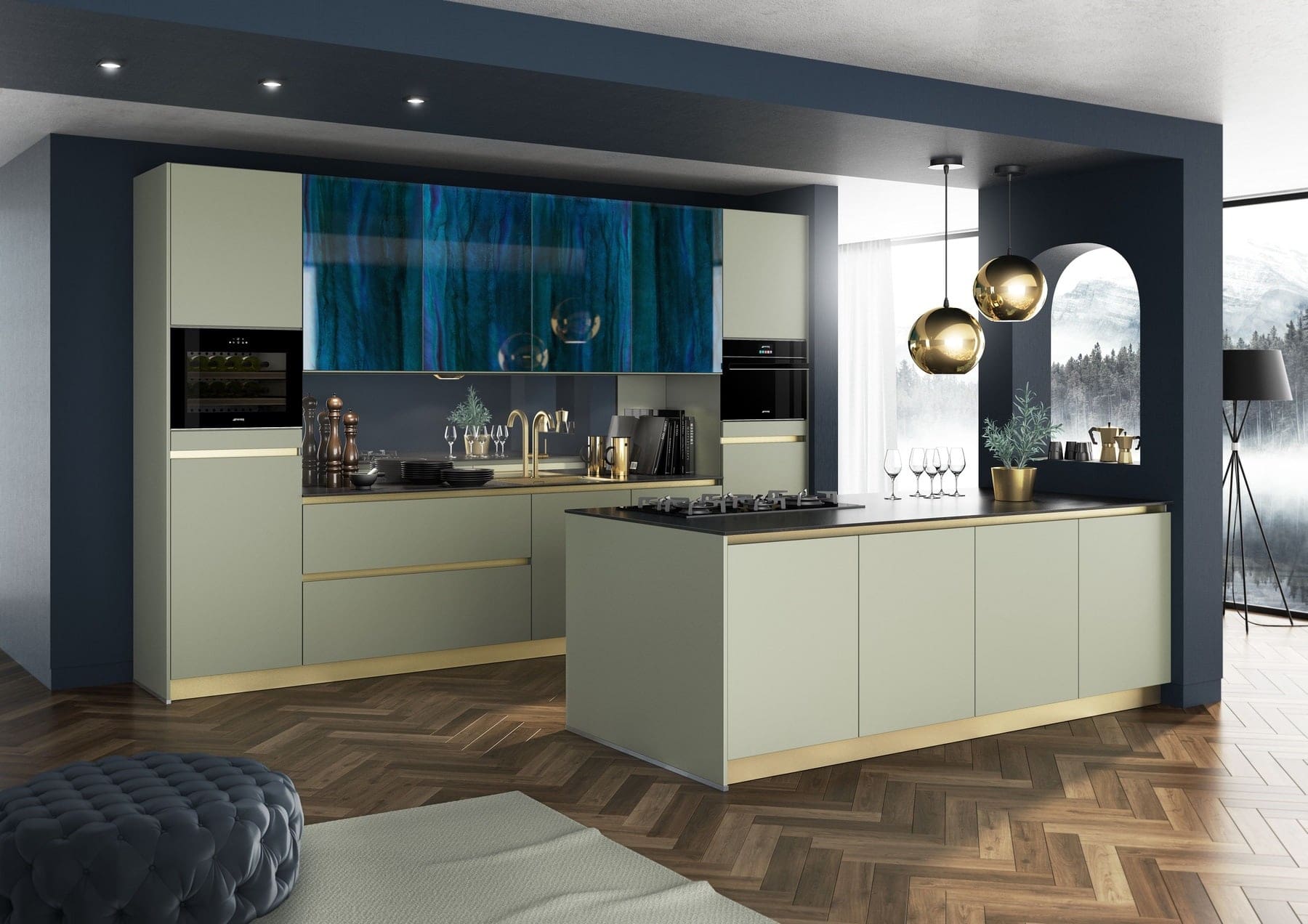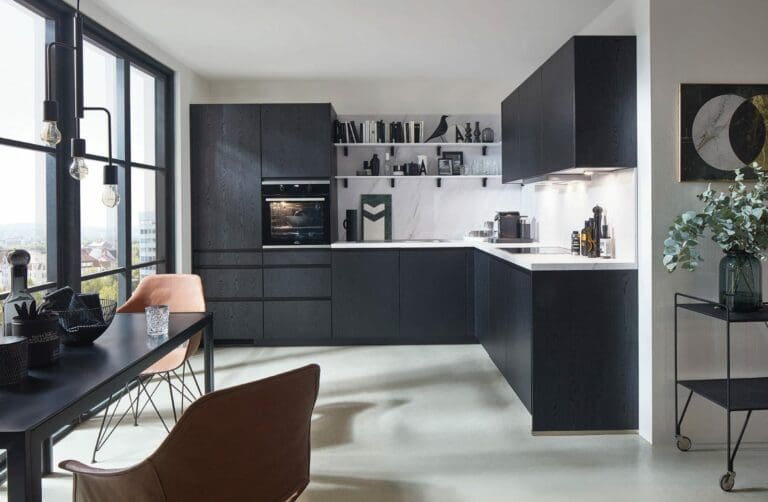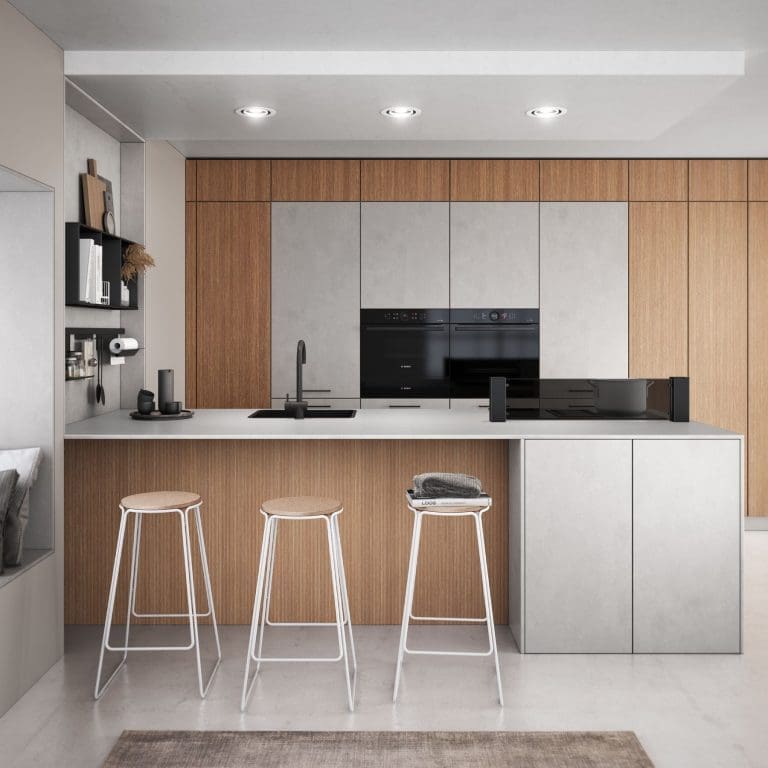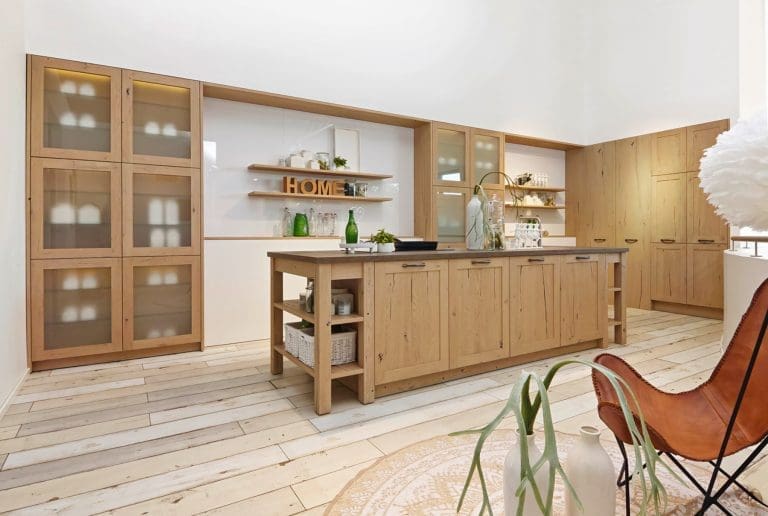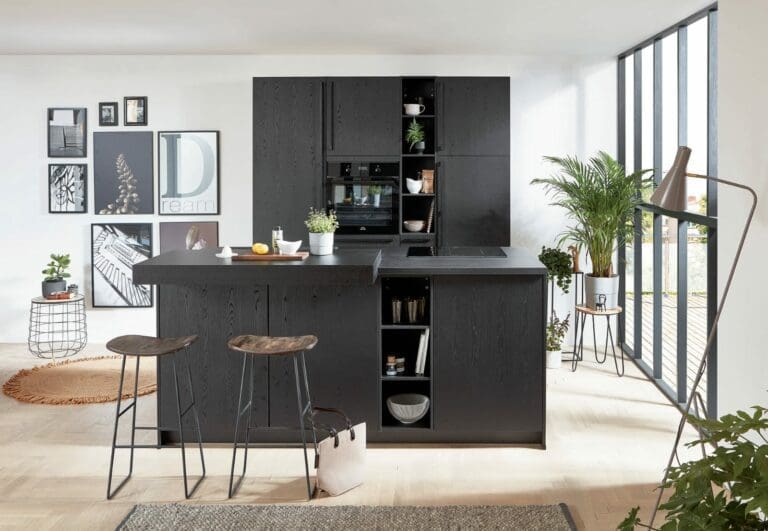Kitchen Door Styles Explained: Shaker, Slab & In-Frame Designs
When you picture your dream kitchen, it’s often the doors that define the look. From timeless Shaker doors to sleek modern slab styles and elegant in-frame designs, kitchen door styles set the tone for your entire space. Each style offers its own aesthetic and practical benefits, influencing everything from cost and maintenance to overall atmosphere.
If you’re planning a new kitchen or updating your existing one, understanding the differences between these three main kitchen door styles will help you make confident, informed choices. Here, our Kitchen Specialists explore each option in depth, with expert advice on what suits different homes, lifestyles, and budgets.
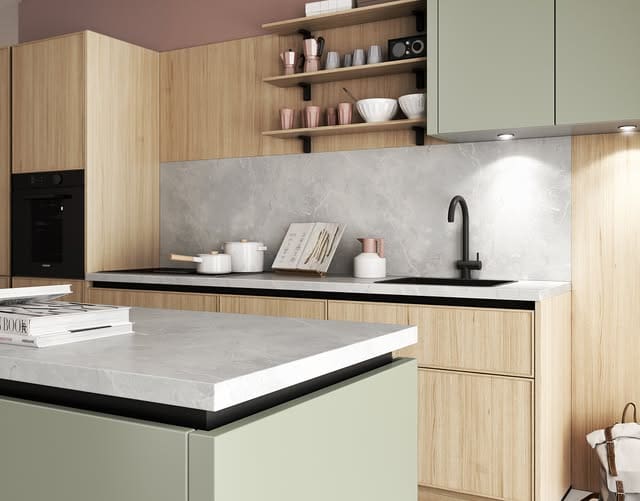
Understanding the Role of Kitchen Door Styles
Kitchen doors are more than just panels that close off storage – they’re one of the largest visual elements in any design. Their material, shape, and finish impact not only the appearance but also the durability and ease of cleaning. Whether you prefer traditional charm, contemporary simplicity, or bespoke craftsmanship, choosing the right kitchen door style ensures your kitchen feels cohesive and functions beautifully.
In the UK, three door styles dominate modern kitchen design: Shaker, Slab, and In-Frame. Each brings a distinct look, and all can be adapted across different materials and finishes — from painted woods to textured laminates.
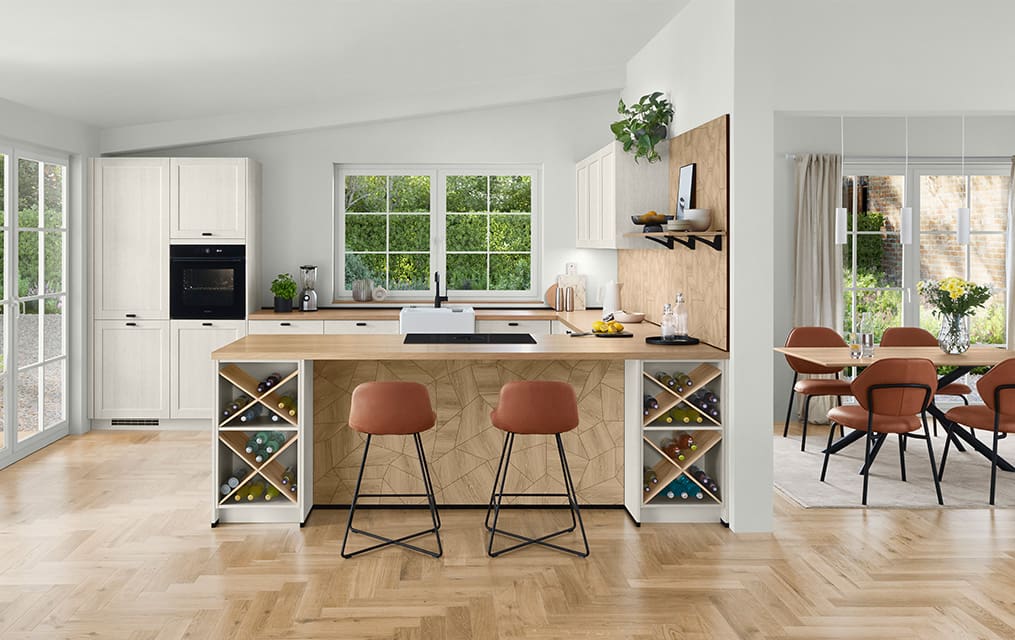
1. Shaker Kitchen Doors: Classic Simplicity with Enduring Appeal
Few designs have stood the test of time like the Shaker kitchen door. Defined by its five-piece construction — a recessed centre panel framed by four rails — the Shaker style is known for its symmetry, balance, and understated beauty.

What Defines a Shaker Door
The classic Shaker kitchen design traces back to 18th-century craftsmanship, where simplicity and practicality were central. Modern interpretations vary from traditional woodgrain finishes to sleek painted versions, giving homeowners the freedom to tailor the look from rustic to refined.
A traditional Shaker kitchen door might feature a visible wood grain, such as oak or ash, ideal for country-style kitchens or period homes. Contemporary versions are often smoother and finished in a single block colour, offering a more modern edge.
Benefits of Shaker Kitchen Doors
- Versatile aesthetic: Shaker doors suit virtually any setting, from period cottages to urban flats.
- Timeless design: They never fall out of fashion, ensuring long-term appeal.
- Range of finishes: Available in painted, lacquered, or vinyl options to suit both budget and preference.
- Easy maintenance: Flat inner panels are easier to clean than highly decorative alternatives.
Styling Tips for Shaker Kitchens
If you want a contemporary take, consider pairing matt painted Shaker kitchen doors in tones like sage green, navy, or graphite with quartz worktops and minimal hardware. German brands such as Bauformat and Brigitte offer precision-engineered Shaker options with ultra-slim frames and seamless painted finishes — blending heritage looks with modern manufacturing.
For a softer, traditional look, British manufacturers like JJO or Alku produce painted timber or woodgrain Shaker doors that capture the warmth and texture of natural materials.

2. Slab Kitchen Doors: Streamlined, Sleek, and Modern
Slab kitchen door styles represent the cleanest expression of modern kitchen design. They’re defined by their flat, smooth surface with no framing or detailing, creating an elegant, minimalist aesthetic that’s both contemporary and highly practical.
What Defines a Slab Door
A slab kitchen door is a single piece of material — typically laminate, lacquer, or painted MDF — with either integrated handles, push-to-open systems, or minimalist edge pulls. This simplicity allows the materials and finishes to take centre stage, from high-gloss acrylics to soft-touch matt laminates.
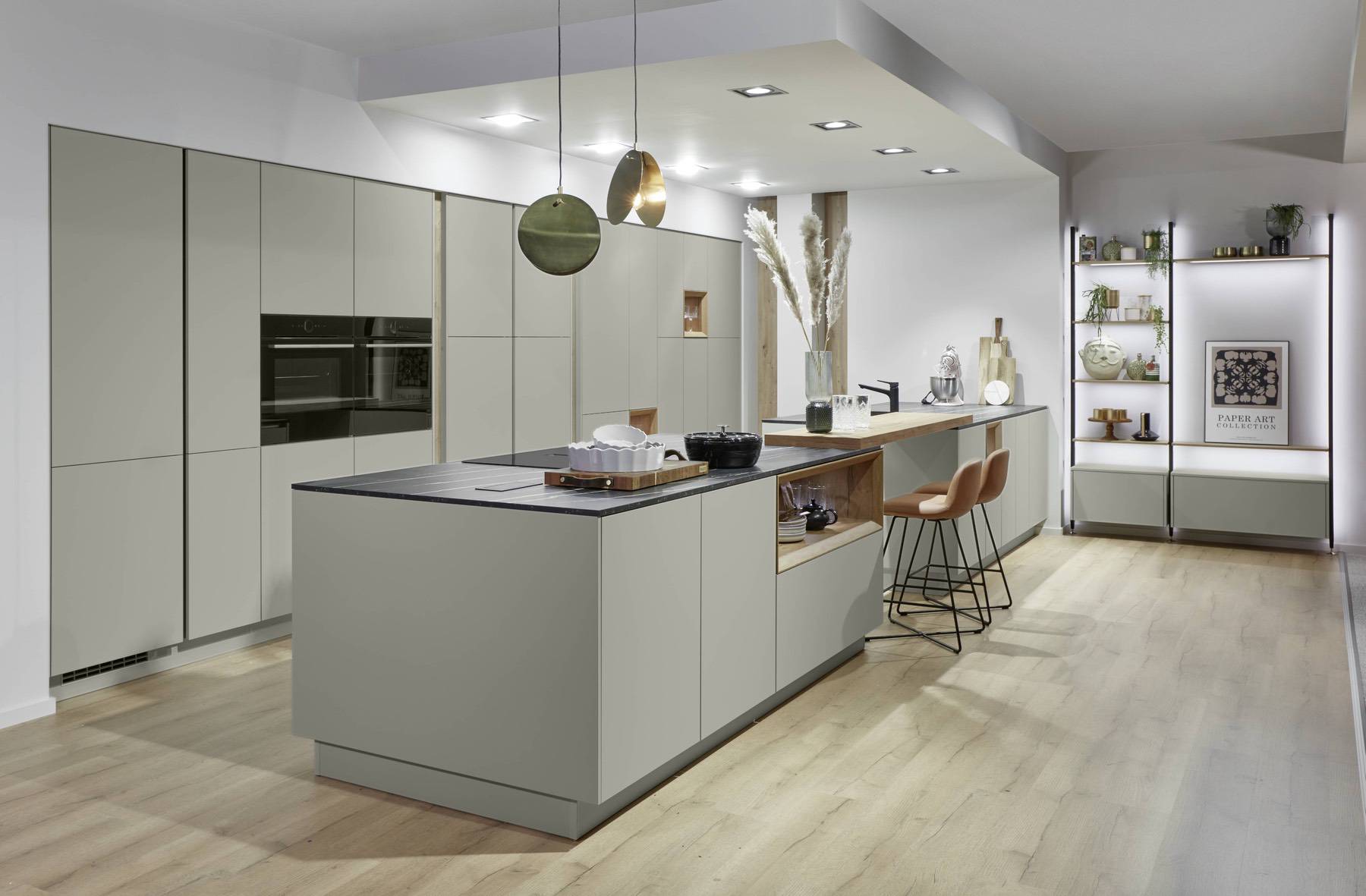
Benefits of Slab Kitchen Door Styles
- Streamlined look: Perfect for open-plan spaces and modern homes.
- Low maintenance: Fewer grooves mean less dust and dirt accumulation.
- Endless finishes: Available in gloss, matt, woodgrain, metallic, and textured effects.
- Affordable options: High-quality laminate and foil-wrapped versions make this style budget-friendly.
Styling Tips for Slab Kitchens
Slab kitchens lend themselves beautifully to handleless designs, where continuous lines create a sense of flow. German brands like Nobilia and Ballerina are renowned for their exceptional slab door collections, offering finishes such as anti-fingerprint matt and concrete-effect laminates that elevate a minimalist scheme with tactile depth.
To introduce warmth, combine slab doors in a neutral shade with a textured woodgrain island or metallic accents. Consider a matt white finish paired with oak trims for Scandinavian-style simplicity, or deep graphite slabs with brass handles for a dramatic, high-end look.
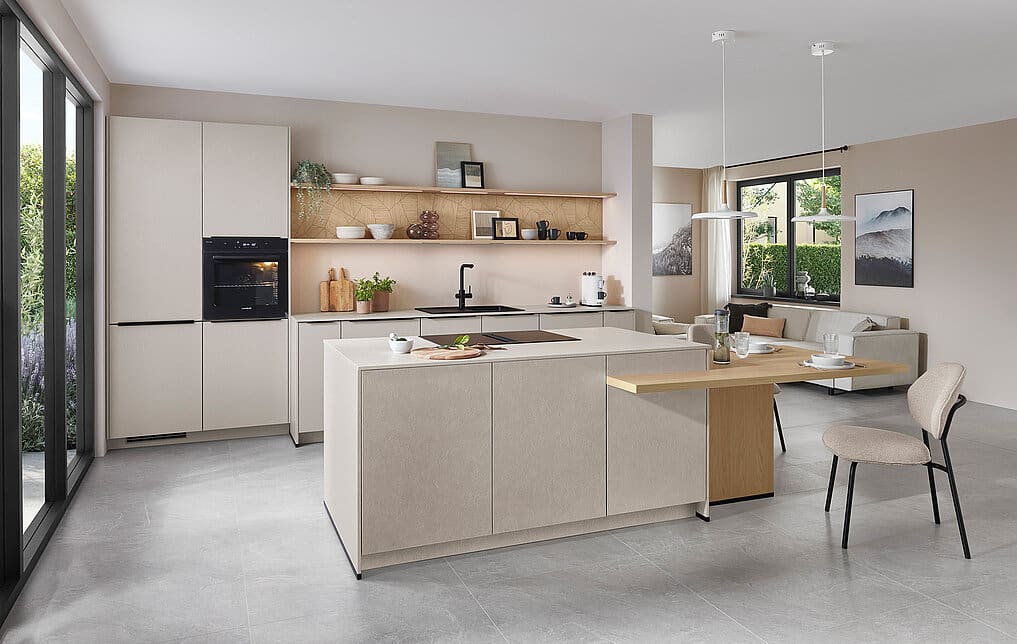
3. In-Frame Kitchen Doors: Craftsmanship and Traditional Detailing
For homeowners seeking true craftsmanship and a bespoke appearance, in-frame kitchens represent the height of design refinement. The name refers to how the door sits within a solid frame that’s attached to the front of the cabinet, rather than overlaying it. This design adds depth, character, and a sense of permanence.
What Defines an In-Frame Kitchen Door
Each door and drawer is inset into its frame, revealing fine joinery and precise alignment. Traditionally crafted from solid timber, modern in-frame kitchens can now combine wood, painted finishes, and even modern composite materials for enhanced durability.
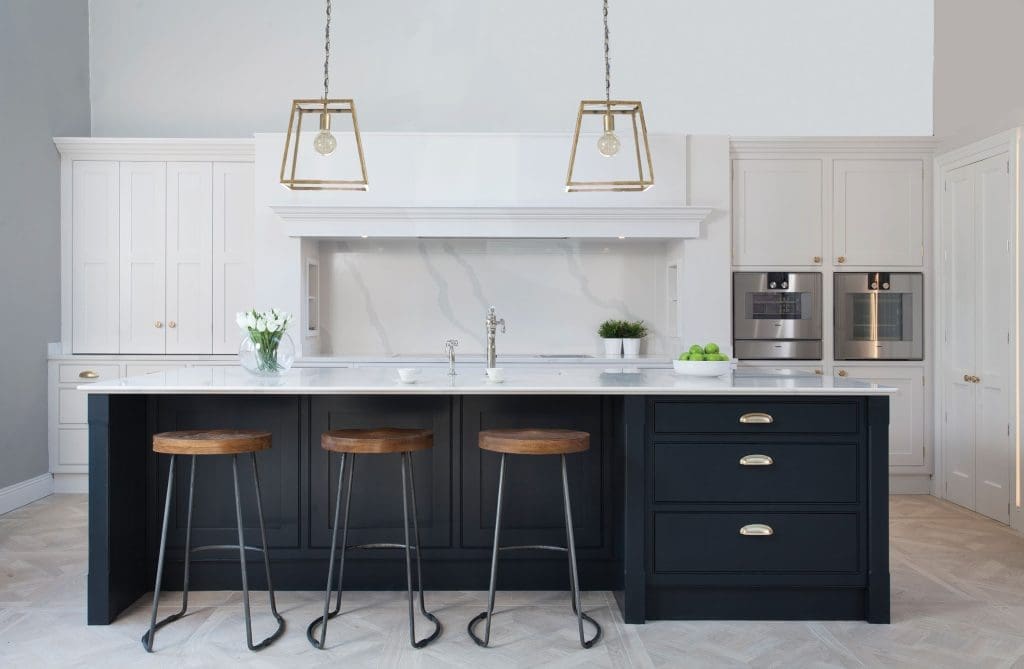
Benefits of In-Frame Kitchen Doors
- Elegant proportions: The visible frame creates beautiful shadow lines and structure.
- Built to last: Often hand-assembled for strength and longevity.
- Customisable design: Frames and panels can be painted or stained in contrasting shades.
- Premium aesthetic: Associated with luxury, craftsmanship, and tailored design.
Styling Tips for In-Frame Kitchens
In-frame doors are a favourite in bespoke British and German kitchen design, where attention to detail is paramount. You might see soft paint tones paired with burnished handles, or a contrasting island in a bold hue for definition.
For a refined but practical approach, Alku and JJO offer in-frame collections that combine traditional joinery with modern manufacturing techniques, achieving luxury aesthetics without the bespoke price tag.
While in-frame designs are more costly than Shaker or slab kitchens, the investment often pays off through exceptional durability and long-lasting elegance.
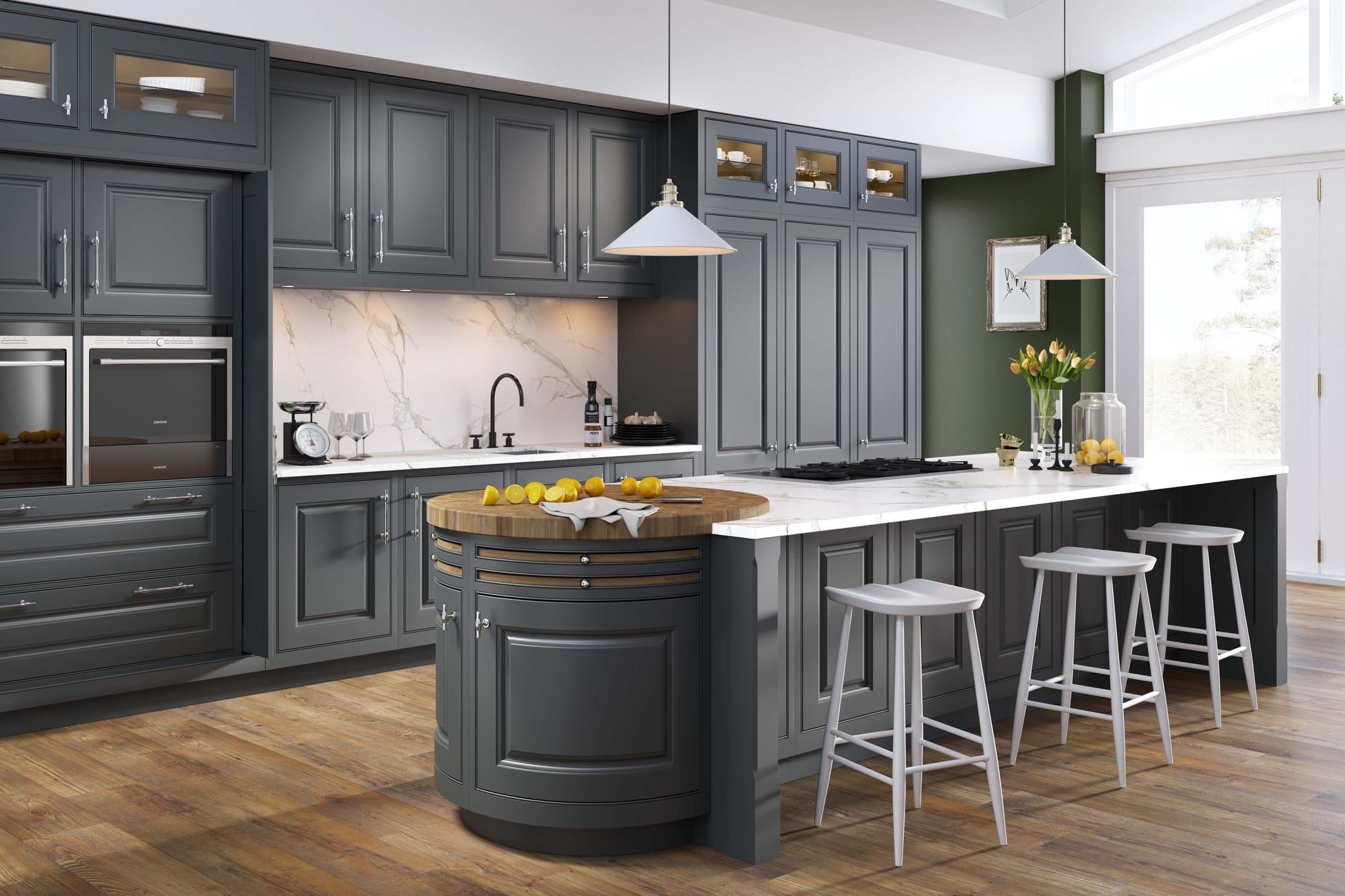
Choosing the Right Kitchen Door Style for Your Home
Selecting the right kitchen door style is about balancing aesthetic preference, budget, and practical needs. Here are some considerations to help you decide which direction suits you best:
1. Consider the Age and Character of Your Home
Older properties with architectural features such as cornices or beams tend to suit Shaker or in-frame styles, while modern apartments or new builds benefit from the simplicity of slab designs.
2. Think About Maintenance and Lifestyle
If you’re after low maintenance kitchen door style, slab doors in laminate or lacquered finishes are ideal. They’re easy to wipe clean, making them perfect for busy families. Painted Shaker kitchen doors may require more gentle upkeep, particularly around the edges, while in-frame kitchens need a little extra care to preserve their fine joinery.

3. Budget and Value
Laminate slab doors offer great value, particularly from efficient German producers like Nobilia, who achieve exceptional quality at accessible prices. Shaker kitchens sit in the mid-range, with versatility across vinyl, timber, or painted finishes. In-frame designs sit at the premium end, often chosen for forever homes where craftsmanship is key.
4. Finishes and Colours
Whichever kitchen
door style you choose, finish and colour make the biggest visual impact.
- Gloss finishes reflect light and visually expand smaller kitchens.
- Matt finishes create a contemporary, tactile quality that feels calm and sophisticated.
- Woodgrain and textured laminates bring natural warmth and depth.
Combining finishes – for example, matt slab doors with a woodgrain island – creates visual balance and individuality.
Sustainability continues to shape the newest kitchen trends for 2026, but it’s also becoming a defining feature of timeless design. Recycled materials, carbon-neutral production, and energy-efficient technologies are now expected rather than exceptional.
Nobilia’s environmental credentials include FSC-certified wood, renewable energy use, and recyclable packaging, while Alku and Bauformat are introducing low-emission lacquers and water-based finishes that maintain both quality and eco-responsibility.
By selecting sustainable materials and well-crafted products, you’re investing in a kitchen that looks good today and remains relevant in the long term — ethically and aesthetically.
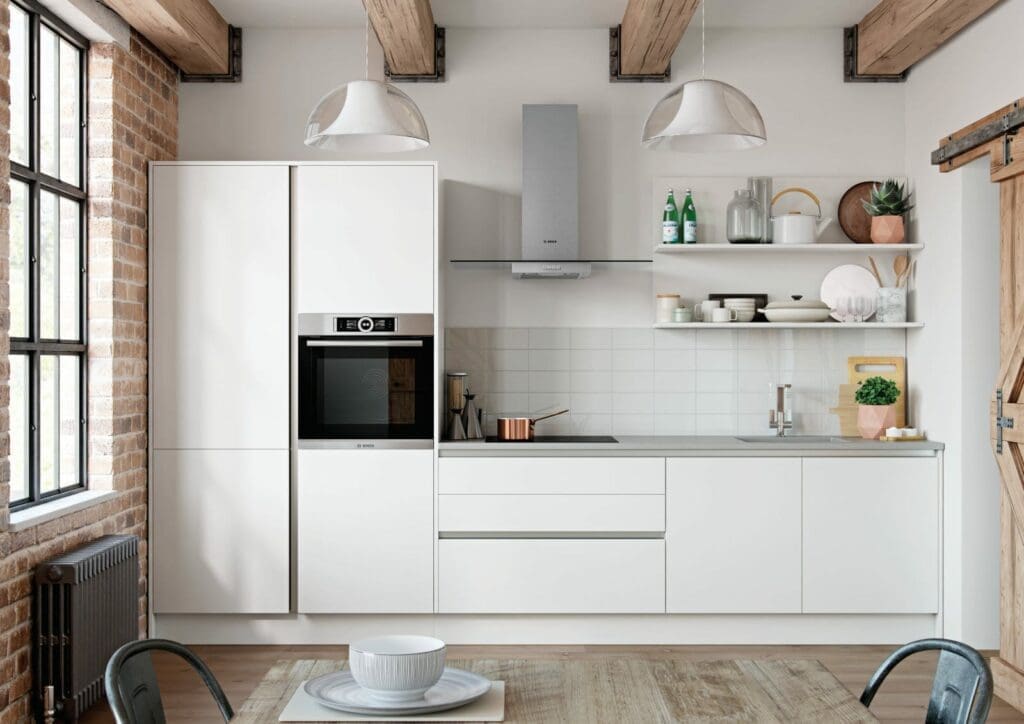
Mixing Kitchen Door Styles
There’s no rule that says you must stick to one style. Combining door types is an increasingly popular trend, allowing homeowners to layer texture, colour, and detail for a truly unique design.
For instance, pairing flat slab wall units with Shaker base units introduces subtle contrast and visual rhythm. Mixing in-frame cabinetry on an island with modern slab units elsewhere adds character and balance. Manufacturers such as Ballerina and Brigitte often design collections that coordinate seamlessly between ranges, making mixed-door kitchens easy to achieve.

Expert Advice on Finishes, Handles, and Layout
- Handles: Shaker and in-frame kitchens look best with traditional cup handles or knobs, while slab kitchens suit integrated, recessed, or push-to-open designs.
- Colour harmony: Use a neutral backdrop, then highlight focal areas like islands or larders in a contrasting tone.
- Lighting: Good lighting enhances every door style — consider under-cabinet LED strips to show off the surface texture.
- Durability: Choose quality hinges and finishes. For example, Nobilia’s laser-edged laminate doors or Bauformat’s lacquered surfaces resist chipping and warping, ensuring long-lasting beauty.

Bringing It All Together
When designed thoughtfully, your kitchen doors define not just the style but the atmosphere of your space. Shaker kitchens bring comfort and tradition, slab doors offer modern simplicity, and in-frame designs celebrate craftsmanship. The right choice depends on your lifestyle, design goals, and how you want your kitchen to feel day to day.
If you’re unsure, visiting a local kitchen showroom is invaluable. Seeing Shaker, slab, and in-frame styles in person lets you appreciate textures, colours, and build quality — and gives you the opportunity to discuss combinations that reflect your taste and home’s character.

Final Thoughts
Every kitchen tells a story, and the kitchen door style you choose is one of the most defining chapters. Whether you’re drawn to the balanced lines of a Shaker, the clean confidence of a slab design, or the heritage quality of in-frame joinery, the right choice will elevate your space both aesthetically and functionally.
Invest in quality materials, take professional design advice where possible, and consider how your kitchen will be used every day. With thoughtful planning and the right door style, you’ll create a kitchen that feels perfectly tailored to you.

